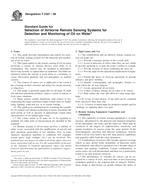Potřebujeme váš souhlas k využití jednotlivých dat, aby se vám mimo jiné mohly ukazovat informace týkající se vašich zájmů. Souhlas udělíte kliknutím na tlačítko „OK“.
ASTM F2327-08
Standard Guide for Selection of Airborne Remote Sensing Systems for Detection and Monitoring of Oil on Water
Automaticky přeložený název:
Standardní Příručka pro výběr šířeného vzduchem DPZ systémy pro detekci a sledování olej na vodě
NORMA vydána dne 15.9.2008
Informace o normě:
Označení normy: ASTM F2327-08
Poznámka: NEPLATNÁ
Datum vydání normy: 15.9.2008
Kód zboží: NS-53566
Počet stran: 4
Přibližná hmotnost: 12 g (0.03 liber)
Země: Americká technická norma
Kategorie: Technické normy ASTM
Anotace textu normy ASTM F2327-08 :
Keywords:
Airborne remote sensing on water, Oil detection and monitoring, Oil spill response, ICS Number Code 13.020.40 (Pollution, pollution control and conservation)
Doplňující informace
| Significance and Use |
|
The contributions that an effective remote sensing system can make are: Provide a strategic picture of the overall spill, Assist in detection of slicks when they are not visible by persons operating at, or near, the water's surface or at night, Provide location of slicks containing the most oil, Provide input for the operational deployment of equipment, Extend the hours of clean-up operations to include darkness and poor visibility, Identify oceanographic and geographic features toward which the oil may migrate, Locate unreported oil-on-water, Collect evidence linking oil-on-water to its source, Help reduce the time and effort for long range planning, A log, or time history, of the spill can be compiled from successive data runs, and A source of initial input for predictive models and for “truthing” or updating them over time. |
| 1. Scope |
|
1.1 This guide provides information and criteria for selection of remote sensing systems for the detection and monitoring of oil on water. 1.2 This guide applies to the remote sensing of oil-on-water involving a variety of sensing devices used alone or in combination. The sensors may be mounted in helicopters, fixed-wing aircraft, or lighter-than-air platforms. Excluded are situations where the aircraft is used solely as a telemetry or visual observation platform and exo-atmosphere or satellite systems. 1.3 The context of sensor use is addressed to the extent it has a bearing on their selection and utility for certain missions or objectives. 1.4 This guide is generally applicable for all types of crude oils and most petroleum products, under a variety of marine or fresh water situations. 1.5 Many sensors exhibit limitations with respect to discriminating the target substances under certain states of weathering, lighting, wind and sea, or in certain settings. 1.6 This guide gives information for evaluating the capability of a remote surveillance technology to locate, determine the areal extent, as well as measure or approximate certain other characteristics of oil spilled upon water. 1.7 The values stated in SI units are to be regarded as standard. No other units of measurement are included in this standard. 1.8 Remote sensing of oil-on-water involves a number of safety issues associated with the modification of aircraft and their operation, particularly at low altitudes. Also, in some instances, hazardous materials or conditions (for example, certain gases, high voltages, etc.) can be involved. This standard does not purport to address all of the safety concerns, if any, associated with its use. It is the responsibility of the user of this standard to establish appropriate safety and health practices and determine the applicability of regulatory requirements prior to use. |
Doporučujeme:
Aktualizace zákonů
Chcete mít jistotu o platnosti užívaných předpisů?
Nabízíme Vám řešení, abyste mohli používat stále platné (aktuální) legislativní předpisy.
Chcete vědět více informací? Podívejte se na tuto stránku.




 Cookies
Cookies
